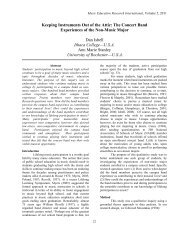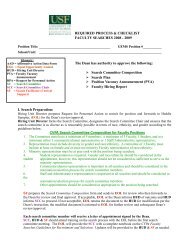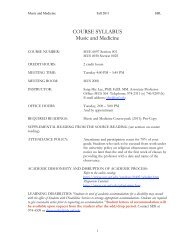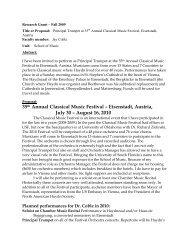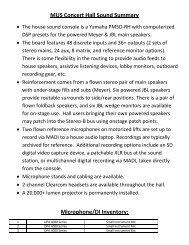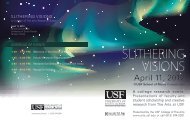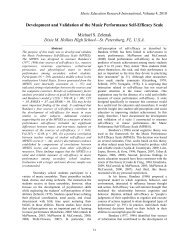2116 Syllabus (Fa 10) - USF Music Advising - University of South ...
2116 Syllabus (Fa 10) - USF Music Advising - University of South ...
2116 Syllabus (Fa 10) - USF Music Advising - University of South ...
You also want an ePaper? Increase the reach of your titles
YUMPU automatically turns print PDFs into web optimized ePapers that Google loves.
MUT <strong>2116</strong> FALL 20<strong>10</strong><br />
MUSIC THEORY III<br />
UNIVERSITY OF SOUTH FLORIDA<br />
BASIC INFORMATION<br />
Pr<strong>of</strong>essor:<br />
J. T. Brasky, Ph.D.<br />
Office:<br />
135E FAH<br />
Email:<br />
brasky@usf.edu<br />
Phone:<br />
813–974–2311 [main <strong>of</strong>fice phone, for messages only]<br />
<strong>Fa</strong>x: 813–974–8721<br />
Class Meetings:<br />
Tuesdays and Thursdays, 7:25 A.M.–9:15 A.M.<br />
Class Location: FAH <strong>10</strong>2<br />
Office Hours (drop-in):<br />
Office Hours (by appt.):<br />
Teaching Assistant:<br />
Tuesdays, 11:00 A.M.–12:00 P.M.<br />
Thursdays, 11:00 A.M.– 12:00 P.M. (limited alternate times also available)<br />
Luke Schwartz (lschwar2@mail.usf.edu)<br />
REQUIRED COURSE MATERIALS<br />
Steven G. Laitz, The Complete <strong>Music</strong>ian: An Integrated Approach to Tonal Theory, Analysis, and Listening. New York: Oxford<br />
<strong>University</strong> Press, 2007.<br />
• Many (if not all) <strong>of</strong> you will own this from Theory I–II with Dr. Scotto.<br />
Steven G. Laitz, The Complete <strong>Music</strong>ian Student Workbook: An Integrated Approach to Tonal Theory, Analysis, and Listening, vols I–II.<br />
New York: Oxford <strong>University</strong> Press, 2007.<br />
Manuscript paper, straight-edge or small ruler, and pencils.<br />
• <strong>Fa</strong>ilure to bring staff paper and other required course materials to class meetings wastes a tremendous amount <strong>of</strong> time. If<br />
it becomes a problem, you will lose attendance/participation points.<br />
• See http: // www.blanksheetmusic.net for free manuscript paper.<br />
Regular internet access, for access to Blackboard, email, and recordings in the Classical <strong>Music</strong> Library<br />
(http://clmu.alexanderstreet.com.proxy.usf.edu/)<br />
• Additional required and supplementary materials will be available on the class’s Blackboard site.<br />
ASSIGNMENTS, COURSE MEETINGS AND DAILY PREPARATION<br />
Expectations—<br />
• Performance in past courses—especially Theory and Aural Skills I–II—will have a DIRECT AND LASTING IMPACT on<br />
your performance in this class. You are expected to be fluent in treble, bass, tenor, and alto clefs, all major and minor<br />
key signatures, diatonic and chromatic harmonic motion, diatonic and chromatic sequences, and standard roman<br />
numeral/figured bass labeling systems. If you are not, brush up on trouble spots during the first week <strong>of</strong> the semester!<br />
• Hand in assignments in a timely fashion. This means that<br />
NO LATE ASSIGNMENTS WILL BE ACCEPTED!<br />
• There is no opportunity for make-up or extra credit work.<br />
• Check your <strong>USF</strong> email account regularly (or forward their mail to another easily accessible account) for announcements<br />
pertaining to classroom activities and assignments.<br />
• Be responsible for the materials presented at each class, including lectures, discussions, and activities as well as all<br />
reading and listening assignments. All assignments will be posted to Blackboard.<br />
Attendance—<br />
Students are responsible for the information, handouts, and assignments given during each session. Regular and punctual<br />
attendance at all class meetings is expected. Attendance will be taken at all class meetings; lateness and/or poor attendance<br />
will directly affect your grade. The daily discussions among your peers and the pr<strong>of</strong>essor will go beyond readings and other
<strong>2116</strong> SYLLABUS (FALL 20<strong>10</strong>)—2<br />
course exercises (otherwise, we’re stuck talking about menial things like how to spell chords and that’s just hellish…). These<br />
should be a source <strong>of</strong> interest, and are a source <strong>of</strong> exam questions.<br />
Excused Absences: illness (as documented by a physician), religious observance (see below), and family emergencies<br />
(as documented by your academic advisor), events sanctioned by the School <strong>of</strong> <strong>Music</strong><br />
• If you plan to miss a class because <strong>of</strong> religious observance, university policy stipulates that students must<br />
notify the pr<strong>of</strong>essor by the second class meeting.<br />
Unexcused Absences: doctor’s appointments, travel, studio lessons, phone calls, parole hearings, or other events that<br />
occur during class time. Other requests for excused absences will be considered on a case-by-case basis.<br />
When absences are unavoidable, please notify me via email or leave a message in the music <strong>of</strong>fice before the class meeting:<br />
813–974–2311. Please note that my <strong>of</strong>fice phone—from the Stone Age—does NOT have voicemail.<br />
NB: All cell phones and similar devices are to be shut <strong>of</strong>f or silenced. They should not be visible during<br />
class and will result in an F on a quiz/exam if they are spotted during a timed, graded event.<br />
Email—<br />
When you email any faculty member, be sure to address them appropriately and sign the email. Remember that what and how<br />
you write reflects on how you are perceived!<br />
• Do not panic if it takes a day or two to receive a response. My priority is to provide accurate information.<br />
<strong>Fa</strong>cebook Policy—<br />
I will not accept friend requests from undergraduates.<br />
QUIZZES AND EXAMINATIONS<br />
• For each, students will be responsible for the material presented and discussed in class, assigned readings, as well as<br />
listenings and other assignments. Quizzes and exams may not be overtly cumulative, but a conceptual understanding <strong>of</strong><br />
the materials from previous units will always be required to answer the questions.<br />
• Both the Midterm and Final will consist <strong>of</strong> short-answer questions, listening questions, analyses, and harmonizations.<br />
Through assignments and quizzes, you will have almost everything on any exam in your hands before the test.<br />
• Pop quizzes are a part <strong>of</strong> life. If you are prepared, they are an easy source <strong>of</strong> good grades.<br />
• No make-up quizzes and/or exams will be given.<br />
Final Grades—<br />
Final grades will be calculated according to the following percentages:<br />
Weekly work [see below] 50%<br />
Attendance, Assignments, Quizzes, and Participation<br />
Midterm Examination [Thursday, October 7] 25%<br />
Final Exam [Tuesday, December 7, 7:30–9:30 A.M.] 25%<br />
GRADING<br />
Weekly Grades—<br />
Weekly grades are calculated according to below template. There are fifteen weeks in the semester.<br />
T R HW Quiz Adj. TTL<br />
[x/20]<br />
%<br />
Morneau, J. – + 9.5 <strong>10</strong> 0 19.5 97.5%<br />
Mauer, J. – – 7.4 6.6 –2 12 60%<br />
Morgan, J. + + <strong>10</strong> <strong>10</strong> +2 22 1<strong>10</strong>%
<strong>2116</strong> SYLLABUS (FALL 20<strong>10</strong>)—3<br />
Key:<br />
T = Tuesday Attendance<br />
R = Thursday Attendance<br />
HW and Quiz grades from <strong>10</strong> points<br />
– = absent or late (more than 5 min)<br />
+ = present, exceptional participation or preparation<br />
The Adj. category is the sum <strong>of</strong> the T & R columns<br />
• Note in Mr. Morneau’s row, the absence on Tuesday is cancelled by the exceptional work in Thursday’s class. This costs<br />
Mr. Morneau no points as a result. However, his classmate, Mr. Mauer, did not attend class on Tuesday (yet had a friend<br />
hand in the assignment at the class meeting), but showed up more than 5 minutes late for Thursday’s class. He loses two<br />
attendance points for the week, lowering his grade from 14/20 (70%) to 12/20 (60%). Note that Mr. Morgan is a<br />
fantastic student and has an average for the week that is well above <strong>10</strong>0%.<br />
• The planned 13 graded homework assignments over the course <strong>of</strong> the semester means that individual assignments are<br />
each worth approximately 3% <strong>of</strong> the final calculated grade. (Assuming about a pop quiz a week, that is.) That means<br />
missing two assignments will essentially reduce the highest possible attainable grade to an A–, three to a B, and so on.<br />
• In weeks where a scheduled university holiday interrupts the regular class schedule (e.g.: Dr. Martin Luther King, Jr.<br />
Day), there will be only one attendance opportunity for the week. If a class is canceled (or if you have been excused),<br />
you will be given credit for attending, although the meeting will not exist.<br />
• In sum, please note that assignments, quizzes, and participation have an enormous effect on one’s final grade.<br />
Understand that a bad week will do some harm to a final grade, but that not handing in more than one assignment has<br />
the potential to substantially lower a final grade. (Missing more than two puts a final grade in serious jeopardy.) It also<br />
makes it much harder to justify awarding strong final grade when one then fails to do well on the exams!<br />
At the end <strong>of</strong> the semester an overall grade percentage will be translated into a letter grade, based on the following<br />
equivalencies:<br />
97–<strong>10</strong>0+ = A+ 93–96 = A 90–92 = A–<br />
87–89 = B+ 83–86 = B 80–82 = B–<br />
77–79 = C+ 73–76 = C 70–72 = C–<br />
67–69 = D+ 63–66 = D 60–62 = D–<br />
59 (or lower) = F<br />
Incompletes will not be assigned except in extraordinary circumstances.<br />
One MUST attain a C– or better to continue into 2117!<br />
ACADEMIC INTEGRITY<br />
All outside sources and other materials used in student assignments must be properly referenced. If I have reason to believe<br />
that a student is cheating or being academically dishonest in any way, proceedings may be instituted to have the student<br />
dismissed from the class, program, and/or the <strong>University</strong>, and a grade <strong>of</strong> FF assigned. It is a given that anyone who cheats<br />
will fail the class. See the following for more information concerning university policy for academic dishonesty and<br />
plagiarism:<br />
http://www.ugs.usf.edu/catalogs/0809/adadap.htm<br />
SUPPORT<br />
Students with disabilities are encouraged to register with Students with Disabilities Services in order to receive academic<br />
accommodations. SDS asks students to notify instructors <strong>of</strong> accommodation needs at least FIVE business days prior to<br />
needing the accommodation. A letter from SDS must accompany this request. Course documents will be made available in<br />
alternate formats if requested in the student’s Memorandum <strong>of</strong> Accommodations.
Week<br />
Class<br />
Actual<br />
Date<br />
Chapter<br />
Topic(s)<br />
Pages<br />
Listening<br />
HW<br />
Reading<br />
HW<br />
Written<br />
HW<br />
In-class<br />
Examples<br />
Misc.<br />
1 1.2 08/24/<strong>10</strong> 15–16 Compound melody, Implied<br />
harmony, motive (intro)<br />
phrase models" (T-PD-D-T in noncadential<br />
patterns); contrapuntal<br />
cadences (PD-D-T in inv at end <strong>of</strong><br />
phrase); PD expansion<br />
2.4 09/02/<strong>10</strong> 17 PD expansion (cont.); subphrases;<br />
composite phrases<br />
356–363 Ch. 15: pp. 356–363<br />
only; Ch. 16:<br />
364–381; syllabus<br />
Wkbk: 15.2c, 15.7a-b Wkbk: Comp Mel 15.2a-b, 15.3;<br />
15.7b-c<br />
1.4 08/26/<strong>10</strong> 16 Motivic Transformation 369–396 Ch. 17: 403–416 SL: 16.1a; 16.2; Wkbk: 16.4 Wkbk: Motives 16.2a-b, d<br />
2 2.2 08/31/<strong>10</strong> 17 Hearing phrases; IV 7 , ii 7 ; "embedded 403–416 Ch. 17: 416–421 Wkbk: 17.81, 17.<strong>10</strong> (1), but add SL: Exercises—17.4a (error<br />
RNs, then produce a stem-slur detection), 17.5b (analysis)<br />
analysis (passage continues at the<br />
top <strong>of</strong> the next page)<br />
3 3.2 09/07/<strong>10</strong> 18 Submediant in 1–6–4 bass prgs; vi-ii-<br />
V-I prgs; vi as PD; deceptive<br />
cadences<br />
3.4 09/09/<strong>10</strong><br />
No Class Meeting: Rosh Hashana<br />
4 4.2 09/14/<strong>10</strong> 18–19 Ch. 18: Context in I–V–vi; 1-7-6-5;<br />
Ch. 19: mediant in bass arpegg.; III in<br />
minor (VII-III as V/III–III);<br />
4.4 09/16/<strong>10</strong> 19–20 Ch. 19: "retrogression" (D-PD); Backrelating<br />
Ds (prolong previous tonic<br />
but do not resolve to one); harm prgs<br />
416–421 Ch. 18: 425–434 Wkbk: 17.11, 17.16, 17.22a SL: Exercises—17.8c as harm<br />
exercise, 17.11c (analysis); Wkbk.<br />
17.15 (determine your own harm<br />
prg w/T-expansion and given<br />
melody)<br />
425–434 Ch. 18: 436–445<br />
Ch. 19: 446–450<br />
434–450 Ch. 19: 450–460 Wkbk: 18.15, 19.2a-c; stem-slur <strong>of</strong><br />
SL: stem-slur <strong>of</strong> p. 444, ex. B<br />
(Mozart K. 333)<br />
450–460 Ch. 20: 461–472 (pay Wkbk: 19.11; stem-slur <strong>of</strong> 19.13a<br />
particular attention to & e (are there back-relating Vs? if<br />
Ex. 20.5, to be so, where?)<br />
discussed in class and<br />
look carefully at<br />
20.1c)<br />
5 5.2 09/21/<strong>10</strong> 20 Ch. 20: Periodic (A/C) structure; 461–476 Ch. 20: pp. 472–483 Wkbk: formal diagrams & stemslurs<br />
<strong>of</strong> Ex. 20.2a-c (label all<br />
phrase models, RNs/fig bass) and<br />
Ex. 20.5b<br />
Due next Tu: Wkbk 18.2 (do NOT SL: Exercises—18.3b (in triple meter<br />
write the 9–8 but instead use a 4–3 with an anacrusis, harm); 18.5b-c<br />
in m. 4, and thus, do NOT have (analysis)<br />
another B-flat in that chord!);<br />
K. 331 Theme (I-V-vi); Dido's<br />
Lament (1-7-6-5 in minor); 18.<strong>10</strong>a<br />
(analysis); VL model on mediant:<br />
19.5; 19.4 (analysis)<br />
Dido, reconsidered (retrogression);<br />
Exs. 19.7–19.9 (harm prg diagrams);<br />
harmonize 19.6c (OVs given);<br />
19.11b (analysis: reduce to SATB<br />
style)<br />
Begin w/wkbk. 20.1; Diagrams on<br />
pp. 464–466 on harmonic contents<br />
<strong>of</strong> A/C phrases; K. 331 for A/C;<br />
20.1c ; SL Ex. 20.1 (p. 473 for<br />
analysis egs.<br />
5.4 09/23/<strong>10</strong> 20 Ch. 20: Periodic structure, cont.<br />
Ch. 21: Sentence structure (intro)<br />
461–476 Ch. 21: 477–485 Wkbk: Ex. 20.9 second example,<br />
Ex. 20.5b; 20.4a-b;<br />
6 6.2 09/28/<strong>10</strong> 21 Ch. 21: Sentence structure 477–485 Ch. 21: 485–494 Wkbk: Ex. 20.<strong>10</strong> (pick meter and SL: Exercises—21.1a, f (analysis);<br />
write out bass w/soprano; no IVs!); map out compositional model<br />
Ex. 21.1a-c (label formal type,<br />
whether a sentence, determine<br />
harm rhythm)<br />
6.4 09/30/<strong>10</strong> 21 Ch. 21: Double period; asymmetrical<br />
periods<br />
485–494 Chs. 15–21 Wkbk: Ex. 21.7b; 21.2c (4 voices) Asymmetrical period: Haydn, St.<br />
Anthony Chorale; SL:<br />
Exercises—21.2d<br />
7 7.2 <strong>10</strong>/05/<strong>10</strong> Catch-up day + Review review Review<br />
7.4 <strong>10</strong>/07/<strong>10</strong> Midterm Examination Ch. 22: 495–504<br />
8 8.2 <strong>10</strong>/12/<strong>10</strong> 22 Ch. 22: Harmonic sequences types 495–504 Pachelbel Rant video Ch. 22: 504–513 Wkbk: Ex. 22.1a-c, 22.2a-b, 22.3ab<br />
SL Exercises: 22.3b–c (analysis);<br />
(add all RNs/FB symbols) [check TMM for others]<br />
8.4 <strong>10</strong>/14/<strong>10</strong> 22 Ch. 22: Writing seqs 504–513 Ch. 23: 514–536 Wkbk: Ex. 22.9 a-e; 22.11<br />
9 9.2 <strong>10</strong>/19/<strong>10</strong> 23 Ch. 23: seqs within phrases; diatonic<br />
seqs w/7th chords (beginning)<br />
501–513 Ch. 23: 514–536 Wkbk: Ex. 22.<strong>10</strong>; Ex. 23.3a-b SL Exercises—23.1a (analysis);<br />
Error in Ex. 17.<strong>10</strong>: under score, the<br />
PD should begin at the start <strong>of</strong> the<br />
second meas.<br />
Ex. 18.17e: there IS a way to make<br />
this (admittedly uncommon)<br />
progression work, without the //5 VL<br />
error Laitz points out. What is it?
9.4 <strong>10</strong>/21/<strong>10</strong> 23 Ch. 23: seqs w/7th chords 514–536 Ch. 24: 537–544 Wkbk: Ex. 23.7; Ex. 23.13a-b<br />
<strong>10</strong> <strong>10</strong>.2 <strong>10</strong>/26/<strong>10</strong> 24 Ch. 24: Applied chords (V & V7 <strong>of</strong> x) 537–544 Ch. 24: 545–550 Wkbk 2: Ex. 24.3 (follow given<br />
directions!);<br />
SL Exercises—24.2 (all), 24.3 [bring<br />
in musical examples!], handout (for<br />
practice)<br />
SL Exercises—24.6 (all), 24.7 [bring<br />
in musical examples!]<br />
<strong>10</strong>.4 <strong>10</strong>/28/<strong>10</strong> 24 Ch. 24: Applied chords (vii <strong>of</strong> x) 545–550 Ch. 24: 537–550 Wkbk 2: Ex. 24.4 (stem-slur, too),<br />
24.5<br />
11 11.2 11/02/<strong>10</strong> 24 Ch. 24: review 537–550 Ch. 24: 551–558 Wkbk 2: Ex. 24.7, 24.8 use old HW for chord spelling &<br />
resolution work<br />
11.4 11/04/<strong>10</strong> 24 Ch. 24: Applied chords and seqs 551–558 Ch. 25: 563–573 Wkbk 2: Ex. 24.18, 24.19, 24.22 SL Exercises—24.12 (harm), 24.14ab,<br />
[SMT—TA coverage]<br />
(chromatic seqs)<br />
bring in other examples (?)<br />
12 12.2 11/09/<strong>10</strong> 25 Ch. 25: Tonicization and modulation 563–573 Ch. 25: 574–586 Wkbk 2: Ex. 24.20 a-b; Ex. 25.2 Wkbk 2: Ex. 25.1, Bring in old<br />
(I—>V)<br />
(UV only?)<br />
I—>V exercises;<br />
12.4 11/11/<strong>10</strong> 25 Ch. 25: Modulation (writing and 574–586 Ch. 25: (review all) Wkbk 2: Ex. 25.7, 25.9 Wkbk 2: Ex. 25.21c, e-f; Ex. 25.23<br />
analyzing mods)<br />
(part); Ex. 25.24<br />
13 13.2 11/16/<strong>10</strong> 25 Ch. 25: Mod wrap-up 587–592 Ch. 26: 587–598 Wkbk 2: Ex. 25.12, 25.13 Wkbk 2: Ex. 25.21a-b, d; Ex. 25.23;<br />
Treasure hunt due on 11/30<br />
13.4 11/18/<strong>10</strong> 26 Ch. 26: Binary form types 593–598 Ch. 26: 598–613 Treasure hunt SL Exercise—26.1 (listening), 26.2<br />
(analysis); TH questions<br />
14 14.2 11/23/<strong>10</strong> Thanksgiving Break



